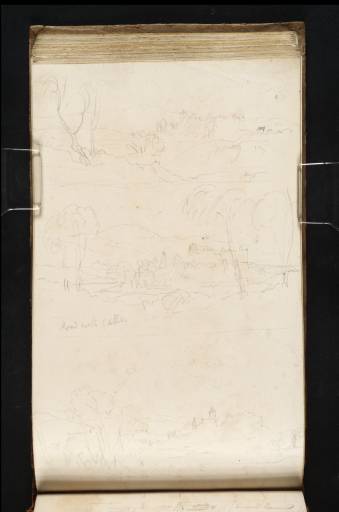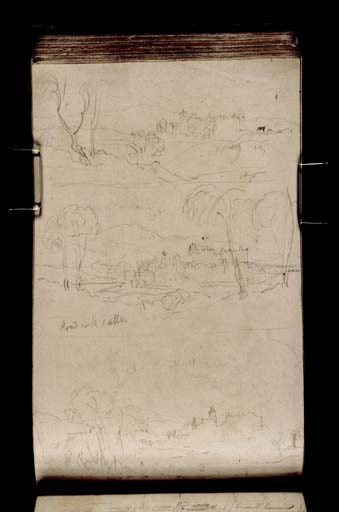Joseph Mallord William Turner Three Sketches of Linlithgow 1818
Image 1 of 2
Joseph Mallord William Turner,
Three Sketches of Linlithgow
1818
Joseph Mallord William Turner 1775–1851
Folio 56 Verso:
Three Sketches of Linlithgow 1818
D13680
Turner Bequest CLXVII 53a
Turner Bequest CLXVII 53a
Pencil on white wove paper, 186 x 112 mm
Inscribed in pencil by Turner ‘Road with Cattle’
Inscribed in pencil by Turner ‘Road with Cattle’
Accepted by the nation as part of the Turner Bequest 1856
References
1909
A.J. Finberg, A Complete Inventory of the Drawings of the Turner Bequest, London 1909, vol.I, p.486, CLXVII 53a, as ‘Three sketches of Linlithgow.’.
1979
Andrew Wilton, J.M.W. Turner: His Life and Work, Fribourg 1979, p.426 under cat.1068 as CLXVII 52–54.
1983
Timothy Clifford, J.M.W. Turner: Aquarelles de la City Art Gallery, Manchester, exhibition catalogue, Musée des Beaux-Arts, Bordeaux 1983, p.39 under cat.10c.
1984
Timothy Clifford and Torsten Gunnarsson, J.M.W. Turner: Akvareller Målningar Grafik, exhibition catalogue, Nationalmuseum, Stockholm 1984, p.48 cat.23.
1985
Timothy Clifford and Shuji Yashiro, Turner at Manchester, exhibition catalogue, Odakyu Grand Gallery, Tokyo 1985, p.[51], cat.18.
1997
Eric Shanes, Turner’s Watercolour Explorations 1810–1842, exhibition catalogue, Clore Gallery, Tate Gallery, London 1997, p.63 cat.46.
With the sketchbook turned to the right, here are three sketches of Linlithgow Palace from across Linlithgow Loch to the north-east. The page is one of three that Turner used in the portrait format and divided into three horizontally, resulting in a series of seven sketches of Linlithgow Palace and Church, with two sketches of views nearby. The other two pages are from the Edinburgh 1818 sketchbook (Tate D13512 and D13513; Turner Bequest CLXVI 32a and 33), and Turner seems to have used the two books simultaneously, perhaps working out his rough designs on the Edinburgh pages before making more careful sketches here. The approach, not used for any other view of the castle, suggests that upon reaching this prospect of the palace, he resolved to develop a subject based upon it.
With a number of detailed studies from various angles already prepared, Turner was now able to concentrate on composition rather than having to record topography and architectural information. The key elements of the subject have been established with all seven of the sketches including Linlithgow Palace, the tower of St Michael’s Church, Linlithgow Loch and, in the distance, the Bathgate Hills. As he experimented with compositions Turner also began to include references to grazing cattle. These elements are all present in the 1821 watercolour of Linlithgow Palace, prepared for the Provincial Antiquities of Scotland (Manchester City Galleries),1 which corresponds closely to the composition of the middle sketch on the present page and the middle sketch of Edinburgh folio 32 verso, with the foreground modelled on the bottom sketch of the present page, and several other sketches.
The top sketch of this page is the most detailed of the three rapidly executed drawings, with the outline of the church and palace represented, and shading indicating that the east side of the buildings are in shadow, while the north sides are lit by the evening sun. We look over the banks of the loch, across the water with a small island of trees in the centre. As with most of the sketches the composition is framed on one side with a tree in the foreground. This sketch is taken from slightly to the north of the two below it, as the Bathgate Hills appear further to the right in the composition.
The hills appear higher and the loch closer in the second drawing, indicating that this view was made from further down the bank, and perhaps slightly to the east. This is consistent with the order of the Linlithgow sketches in this sketchbook which suggest that Turner walked around the palace clockwise. Again there is an interest in framing the view of the palace and church with foreground trees, this time on both sides. The two trees on the right form the basis for those in the watercolour which are the same shape and are in the same position. The rounded wooden spire of the Town House (see folio 52; D13663; CLXVII 45b) is visible in this sketch, to the left of the spire of St Michael’s Church. At the bottom left of the drawing is the inscription ‘Road with cattle.’ The Provincial Antiquities picture includes cattle grazing at the left of the picture.
This sketch broadly corresponds with the middle sketch of a page in the Edinburgh 1818 sketchbook (Tate D13512; Turner Bequest CLXVI 32a), which may have been made from a more eastern position, but similarly uses trees in the foreground to frame the composition on both sides.
For the bottom sketch, as in sketches in the Edinburgh, 1818 sketchbook (bottom of Tate D13512 and the top and middle of D13513; Turner Bequest CLXVI 32a and 33), Turner has again moved a little round the loch to the east, so that the loch is shifted to the right of the composition, while the Bathgate Hills appear to the left of the Palace. St Michael’s Church is now seen to the left of Linlithgow Palace instead of behind it. The shallow bank of the loch forms the basis for the left foreground of the watercolour where the cattle graze, and there may even, as Shanes suggests, be cattle roughly sketched at this point.2 This part of the watercolour is perhaps based more directly on the bottom sketch of a page in the Edinburgh, 1818 sketchbook (D13513), where Turner inscribed ‘cattle’.
Thomas Ardill
March 2008
How to cite
Thomas Ardill, ‘Three Sketches of Linlithgow 1818 by Joseph Mallord William Turner’, catalogue entry, March 2008, in David Blayney Brown (ed.), J.M.W. Turner: Sketchbooks, Drawings and Watercolours, Tate Research Publication, December 2012, https://www


